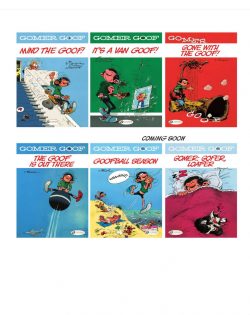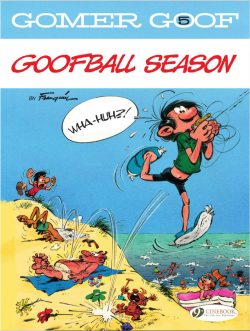

By Franquin & Delporte, translated by Jerome Saincantin (Cinebook)
ISBN: 978-1-84918-462-5 (PB Album/Digital edition)
Like so much in Franco-Belgian comics, it started with Le Journal de Spirou. The magazine debuted on April 2nd 1938, with its engaging lead strip created by Rob-Vel (François Robert Velter). In 1943, publishing house Dupuis purchased all rights to the comic and its titular star, after which comic-strip prodigy Joseph Gillain (Jijé) took the helm for the redheaded kid’s exploits. Ultimately the publisher, and editorial office would become characters in their own periodicals…
In 1946 Jijé’s assistant André Franquin was handed creative control of the Spirou strip. He gradually switched from short gag vignettes to extended adventure serials, introducing a broad, engaging cast of regulars and in 1952 created phenomenally popular wonder-beast The Marsupilami. Debuting in Spirou et les héritiers, this critter grew into a spin-off star of screen, plush toy stores, console games and albums in his own right. Franquin continued crafting increasingly fantastic tales and absorbing Spirou sagas until his resignation in 1969.
Franquin was born in Etterbeek, Belgium on January 3rd 1924. Drawing from an early age, the lad only began formal art training at École Saint-Luc in 1943. When the war forced the school’s closure a year later, he worked at Compagnie Belge d’Animation in Brussels, where he met Maurice de Bévére (AKA Lucky Luke creator “Morris”), Pierre Culliford (“Peyo”, of The Smurfs and Benny Breakiron) and Eddy Paape (Valhardi, Luc Orient). All but Peyo signed on with Dupuis in 1945.
Franquin began as a jobbing cartoonist and illustrator, producing covers for Le Moustique and scouting magazine Plein Jeu. During those early days, Franquin and Morris were tutored by Jijé: the chief illustrator at LJdS. He transformed them – and fellow newbie Willy Maltaite (AKA “Will” – Tif et Tondu, Isabelle, Le jardin des désirs) – into a smoothly functioning creative bullpen known as La bande des quatre or “Gang of Four”. They would revolutionise Franco-Belgian comics with their prolific and engaging “Marcinelle school” style of graphic storytelling…
Jijé handed Franquin all responsibilities for the flagship strip part-way through Spirou et la maison préfabriqué (#427, June 20th 1946) and eager office junior ran with it for two decades; enlarging the feature’s scope and horizons until it became purely his own. Almost weekly, fans met startling new characters like comrade/rival Fantasio or crackpot inventor and Merlin of mushroom mechanics the Count of Champignac…
Spirou & Fantasio were reimagined as a globetrotting journalist team: visiting exotic places, exposing crimes, exploring the fantastic and clashing with a coterie of bizarre and exotic arch-enemies.
Throughout all that revolutionary reinvention, Fantasio was still a full-fledged reporter for Le Journal de Spirou and had to frequently pop back to the Dupuis office. Sadly, lurking there – or was it just in the artist’s head? – was an accident-prone, smugly big-headed office junior in charge of minor jobs and dogs-bodying. Franquin dubbed him Gaston Lagaffe…
There’s a long history of fictitiously personalising those mysterious back room creatives and all the arcane processes they indulge in to make our favourite comics, whether it’s Stan Lee’s Marvel Bullpen or DC Thomson’s lugubrious “Mr. Editor” and underlings at The Beano and Dandy. Let me assure you that it’s a truly international practise and the occasional asides on text pages featuring well-meaning foul-up/office gofer Gaston (who debuted in #985, cover-dated February 28th 1957) grew to be one of the most popular components of the comic, whether as short illustrated strips or in faux editorial reports in text-feature form.
On a strictly personal note, I still think current English designation Gomer Goof (this name comes from an earlier, abortive attempt to introduce the character to American audiences) is unwarranted. The quintessentially Franco-Belgian tone and humour doesn’t translate particularly well (la gaffe translates as “blunder” not “idiot”) and the connotation contributes nothing here. When he surprisingly appeared in a 1970s UK Thunderbirds annual as part of an earlier syndication attempt, Gaston was rechristened Cranky Franky. Perhaps they should have kept that one or, best of all, his original designation…
In terms of actual schtick and delivery, older readers might recognise beats of Benny Hill and Jacques Tati in timeless elements of all-consuming, grandiose self-delusion, and spot recurring situations from Some Mothers Do Have ’Em or Mr Bean. It’s all sublimely set up surreal slapstick, paralysing puns, infernal ingenuity and warped invention, with pomposity lampooned, slovenly sloth celebrated and no good deed going noticed, rewarded or unpunished…
As previously stated, Gomer makes his living (let’s not dignify or mis-categorise what he does as “work”) at the Spirou editorial offices: occasionally reporting to go-getting journalist Fantasio, when not complicating the lives of office manager Léon Prunelle and other staffers. He generally ignores the minor design jobs like paste-up, “gofer-ing” and office maintenance he’s paid to handle as well as editing readers’ letters… the official reason why fan requests and suggestions are never answered…
Gomer is lazy, peckish, opinionated, ever-ravenous, impetuous, underfed, forgetful and eternally hungry, with his most manic moments all stemming from “inventing” labour-saving follies, cutting work corners (often load-bearing walls) and stashing or illicitly consuming contraband food in the office…
This causes constant clashes with his co-workers and his smugly superior attitude comfortably extends to police officer Longsnoot and fireman Captain Morwater. However, the office oaf remains eternally easy-going and incorrigible. Only two questions are really important here: why does Fantasio keep giving him one last chance, and what can gentle, beguiling, flighty, impressionable, utterly lovelorn secretary Miss Jeanne possibly see in the self-opinionated idiot?
This 8th collection of strips culled from the pages ofLe Journal de Spirou was originally released in 1970 as Gaston – Lagaffe nous gâte and became Cinebook’s fifth translated tome. It contains more short cartoon tales and rapid-fire all-Franquin comics gags in single-page bursts, with additional mirth contributed by frequent comic confrère Yvan Delporte – Spirou’s editor-in-chief from 1955-1968 and constant ideas man for not only the Goof, but also Idées noires, Isabelle, The Smurfs and many more.
In this instance that partnership includes a brace of comedic text “reports” from the comic magazine’s editorial page in an emphatic and outlandish Look behind the scenes: detailing in two parts ‘The Wonderful World of the Goofophone’ in two revelatory instalments offering insight into the remarkable instrument/atrocity weapon. His devastating musical contraption – also known as the truly terrifying Brontosaurophone – again disrupts commerce, glass, flora, fauna, the environment and most other organic life in earshot…
The techno-nonsense resumes with a chilling and literally shocking advance in scarecrow development, interspersed with the inventor’s crippling intermittent bouts of ailments, bugs and occupational sloth and ennui, only held at bay by another war over parking tickets with officer Longsnoot. The motorised monstrosity Gomer calls his car is an appallingly decrepit and dilapidated Fiat 509 auto(barely)mobile. It is desperately in need of his many well-meant attempts to counter its lethal road pollution emissions. It’s also the main reason he always has the sniffles or wears some kind of bandage, plaster or splint…
Here, Miss Jeanne is further beguiled by Gomer’s solution to broken zips, but less sanguine at his innovations in broaching walnuts: a repeating theme that over weeks shakes buildings, wrecks bowling balls and derails public transport…
Even when she finally gets the big fool alone in the country, all he can think of is playing his infernal musical howitzer. The results would make any sane man question the inventor’s green credentials and ability to hear in human ranges…
There’s a greater role for neighbouring architects/engineers Gutsy & Irongrip who briefly and painfully experience the power of the Goof after he mistakenly misses the door to the Spirou offices. They would probably have paid a fortune for the phenomenal hyper-elastic building material that emerged from his latest home bakery sessions…
More fruitless attempts to sort the mag’s mail and park his beloved car fall foul of air pollution, poor weather and wandering attention: only confirming that cars, chemistry sets and snow do not belong together. Moreover, his unceasing efforts to modernise and automate the office and studio (despite violent resistance and panicked pleas) still fall short of his own high standards and expectations.
The world is simply not ready for the kind of doors, telephones, executive toys, and entertainment systems his febrile mind can conceive of…
All that brainwork naturally exhausts a fellow and many instances here show how a brief nap might be misunderstood as sheer laziness. It’s just like his many well-meaning attempts to mollify ever-outraged financier De Mesmaeker (in-joke analogue of fellow creator Jidéhem – AKA Jean De Mesmaeker): the explosively irate businessman whose ever-failing efforts to get his contracts signed somehow render him a constant and unfortunate victim of the Goof’s particular brand of misfortune…
At least birds and beasts love Gomer, although being followed by a flock of massed avians, a herd of horses and the giant fly he created does upset those around him. Perhaps it’s his quest to invent a completely natural-scented air freshener?
Whatever the cause – or short-term effects – nothing can long deter the young wonder from his dream of making the world a different – if not actually “better” – place.
This volume ends with a controversial cartoon that raised the ire of The French National Natural Gas Distribution Company/Gaz de France when first seen in the seventies. The corporations PR team had taken legal umbrage to some of Franquin’s satires and demanded redress in print. He complied, but in a way that only inspired even more cartoon calumny and commentary…
Far better enjoyed than précised or described, these strips allowed Franquin to flex whimsical muscles and even subversively sneak in some satirical support for his beliefs in pacifism and environmentalism. However, at their core the gags remain supreme examples of all-ages comedy: wholesome, barbed, daft and incrementally funnier with every re-reading.
Have you started Goofing off yet?
© Dupuis, Dargaud-Lombard s.a. 2009 by Franquin. All rights reserved. English translation © 2019 Cinebook Ltd.
